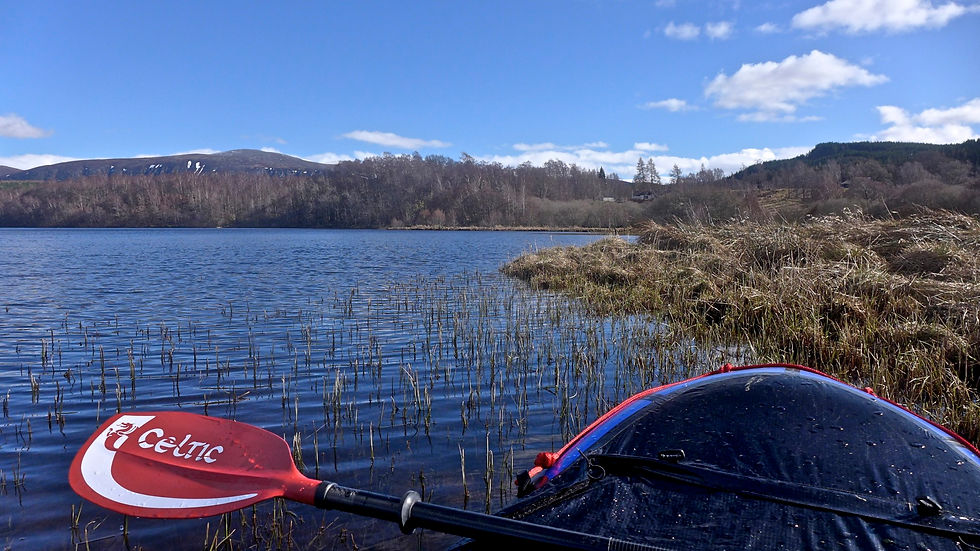Packrafts – a revolution in wild land travel
- cameronmcneish
- Mar 25, 2015
- 4 min read

A packrafting selfie
IN an interview I did with the sea kayaker Brian Wilson some years ago I suggested that our forefathers travelled largely by sea because so much of the land was forested and difficult to travel through.
Brian agreed, suggesting the seas were the highways of the time, the motorways, and it was because of the sea, and the crafts that were plied upon it, that communications were so good between islands and even between countries.
For most of my life I’ve planned backpacking trips that avoided large expanses of water – I’ve seen them as a potential hazard or as a barrier to progress but over the past couple of years or so I’ve been aware of backpackers planning routes that utilised expanses of water, whether it be the sea, lochs or lakes or even whitewater rivers.
In short these intrepid backpackers have revolutionised wilderness exploration and travel.
They have done this by using packrafts, lightweight, inflatable boats that can be easily carried in a pack. To quote wilderness packrafter and author Roman Dial; “The packraft may be the single most liberating tool for exploring wilderness developed in the last few decades.”
Dial has written what is, as far as I am aware, currently the only users’ guide to packrafting. “Packrafting – An Introduction and How-to Guide” is published by Backpacking Light and is an inspiring little tome, full of photos of these tiny inflatable boats in very uncompromising whitewater situations.
Dial describes some of the trips that packrafts have accomplished; “In 2004 a young couple used Alpackas (the most popular model of packraft) to fjord-hop along Alaska’s glacier-draped coast, a gang of climbers packrafted the Nahanni River to climb Canada’s Lotus Flower Tower, and a group of Scandinavians made long, Class 1V first descents in Norway. In the 2005 Wilderness Classic, a team of four ran through the Talkeetna Mountains, then floated the Class 1V Talkeetna River, crossing 160 miles of wilderness in forty-seven hours, the fastest pace in the history of the race. And by 2006, Class V kayakers were switching to Alpackas and running steep creeks and even hucking off of twenty-five foot waterfalls. The packrafters’ time had come.”
Wilderness adventurers have been using packrafts in Europe for a few years now and a colleague on walkhighlands.co.uk, David Lintern, is shortly to begin a coast to coast walk across Scotland taking in our highest mountains and floating across lochs and down rivers whenever he can.

What makes the packraft such a versatile bit of kit is its light weight and packability My Alpacka Yukon Yak weights a tad under 5lbs and packs down to the size of a two person tent. The paddles break down into four sections for portability.
Alpacka packrafts are manufactured in Alaska but are brought into this country by Back Country Biking of Aviemore – www.backcountrybiking.co.uk
Now I’ve done a bit of paddling in the past, mostly sea kayaking, but I’ve been intrigued by the possibilities packrafts offer, especially to someone of my advancing age. The thought of floating down a river instead of walking alongside it appeals to me and it is easy to transport big packs, and even bikes, on a packraft.
I have a couple of bigger trips planned for later in the spring but for the moment I’ve been enjoying some play-trips on local lochs and rivers. Today, with the sun uncharacteristically shining from the March sky, I paddled across Loch Insh and into the mouth of the Spey. I followed the river towards Kingussie through the Insh Marches, an RSPB reserve that, by its waterlogged and boggy nature, is normally out of bounds to walkers.

The mouth of the River Spey at the south end of Loch Insh
I had long wanted to canoe this part of the Spey but for a variety of reasons had never got round to it so it was a delight to paddle upriver on this spring day listening to the call of curlews, oystercatchers and lapwings.
At one point I silently floated towards a stationary heron who waited until the last possible moment to take off, heavy wings beating the air like some ancient pterodactyl.
Buzzards mewed overhead, marking their breeding territories, and chaffinches twittered on the riverside alders.
I was surprised how quickly I made progress, even upstream, and it was wonderful to eventually spin round and float downstream just as quickly, without even having to paddle.

The Alpacka Yukon Yak
It was great fun, but easy fun and I’m looking forward to sunny summer evenings floating down the Spey from Kingussie to Loch Insh or from Loch Insh down to Aviemore where I can stop, have a pint or two, hoist my packraft into a day pack and come home by bus.
But best of all I’m looking forward to packing my camping gear and floating off down some North-West highland river or loch for a wild and remote camp somewhere. Or I might even load my bike in the packraft and combine a few days rafting and bikepacking.
As I said earlier, the packraft has revolutionized wild land exploration and travel. I suspect it’s going to prove highly popular.

Looking up from the Spey to the Glen Feshie hills and Choire Gharblach


























Comments